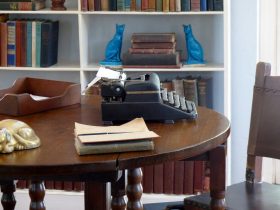Newest contributor to Arts Hub UK Melissa Mostyn is set to join us with the monthly column, Deaf Zone. Originally a fashion journalist, Melissa is now turning a lifelong love of the arts into a career as an arts marketing practitioner and visual artist. She has recently been awarded funding from Arts Council England to run a year’s pilot scheme of professional development with Salon, a group of deaf visual artists in the South-East.
Deaf since the age of 16 months, Melissa’s passion is to support other deaf visual artists. She has already made her mark in several areas of the arts since 2003, when she debuted in Hidden Visions at Chats Arts Palace in east London, and followed up with Composition, a deaf arts showcase at Light House, Wolverhampton, which she also curated. She gives gallery talks in BSL regularly at major art galleries and museums across London.
We asked Melissa about her work:
‘It has been an absolute passion of mine since 2003 to ensure that deaf visual artists get the exposure and motivation they need to further their own professional development. It’s not training they need – more an opportunity to make art, enter critical debate, share ideas and network with like-minded visual artists in a mutually supportive and inclusive environment.
‘There are many, many professional development opportunities for mainstream visual artists – such as seminars, forums, workshops, lectures, and networking events – but far too few take into account deaf visual artists’ access needs. You can’t develop contemporary visual art in a vacuum and expect it to impact on people just like that – you need to have some sort of support infrastructure first, whether at college or later in life. Bacon had all his artist friends, so did Picasso and Hockney – that’s how they were able to develop and prosper and eventually gain recognition. I want to see the same thing happening to deaf visual artists.
‘Unfortunately British deaf visual art remains underdeveloped for several reasons: a. communication barriers to professional development opportunities; b. lack of deaf arts resources or funding, which forces them to take jobs away from their practice; c. discriminatory attitudes within the mainstream arts, of which I am sad to say, still exist; and d. lack of time and space in which to work – a knock-on effect of the lack of available resources. There are further repercussions in that such barriers lead to deaf visual artists being neglected for long periods of time thus causing them to lose motivation.
‘On top of that there has been a tendency for some years to assume that deaf creativity is better served by theatre, performance, film and television. While I don’t dispute the genuine talent that resides in the performing and film-making arts, it would be foolish to ignore the capacity of visual art for multi-layered deaf creative expression. You only have to look at De’VIA in the United States for proof of what can be achieved with the right support and encouragement.
‘I also have historical records of internationally-renowned deaf and hard-of-hearing visual artists going as far back as the 15th century so what’s changed? Deaf people have been around as long as history itself!
‘I would like to emphasise that other than my own desire to see deaf visual artists succeeding as equals, I have no political bias. As a freelance Arts Marketing Co-ordinator I am there to promote and support deaf visual artists regardless of their chosen themes and subjects. Through my own dedicated PR, publicity and writing I aim to boost deaf visual artists’ media profiles and I do this by exploiting my own journalistic and marketing skills and experience. This works in many ways. One minute I could be developing publicity with a deaf artist about to launch a brand-new installation; the next, I could be introducing a mainstream art gallery to deaf artists for future events or discussions revolving round their practices. At present I am advising Arts Council England (ACE) on getting more deaf artists involved in their commissioned three-year South-East arts project, Inside Out.’
It is hardly surprising that Melissa finds herself in the world of the arts. From a family that boasts five artists and seven writers, she was encouraged to read, write, draw and observe from early childhood – a gift she values highly. Holidays abroad imbued her with a love of the Renaissance that has never diminished and which informs much of her drawing.
Melissa’s deep understanding of the needs of deaf visual artists commits her to offer her support and advocacy. Sooner rather than later, she hopes to establish the UK’s first deaf visual art consortium.
In her monthly column, Melissa will share with Arts Hub readers the journey she is taking as a deaf artist and the progress of the Salon initiative.
We are delighted to welcome Melissa to the Arts Hub team.




